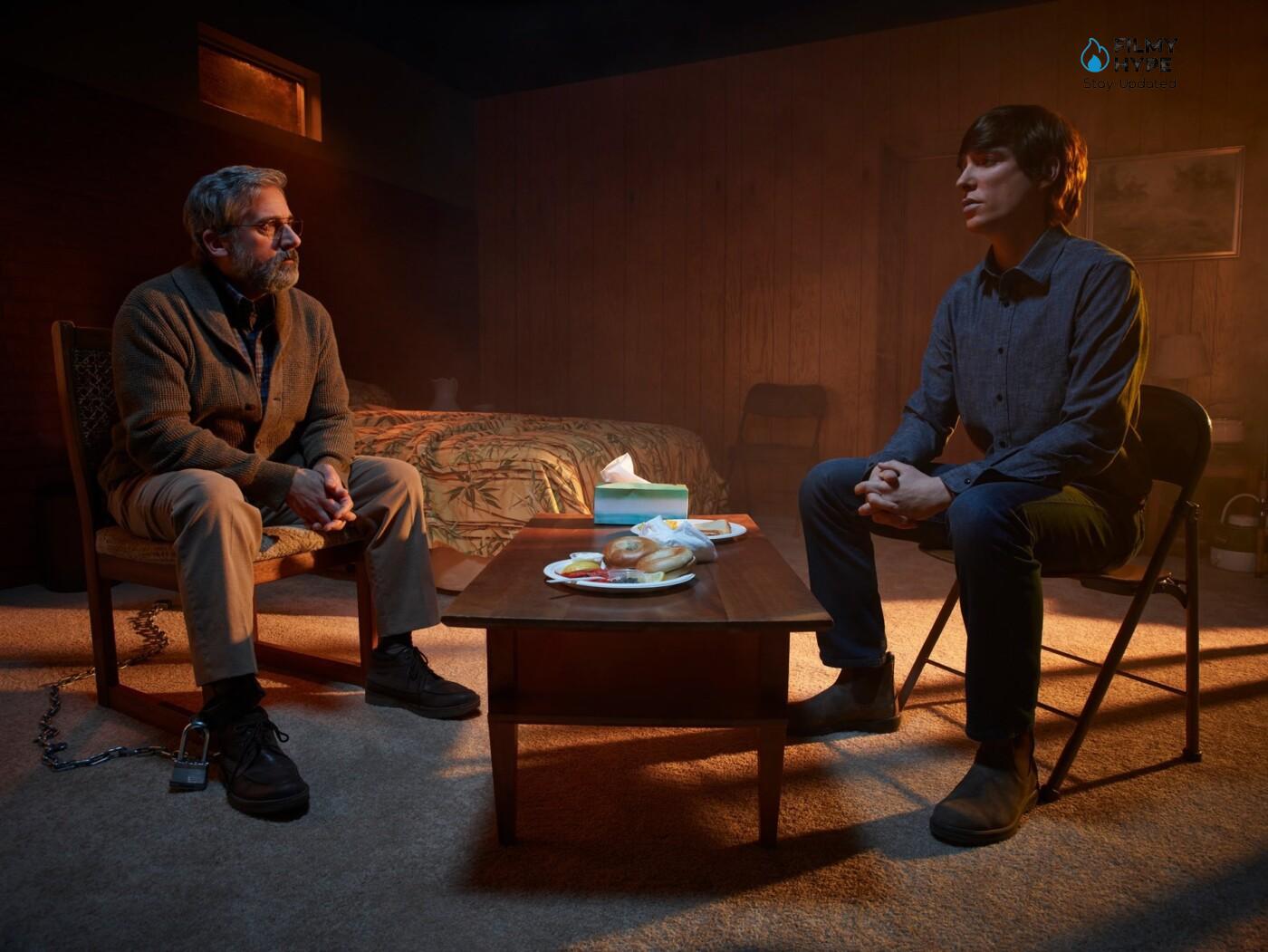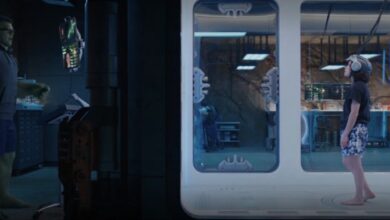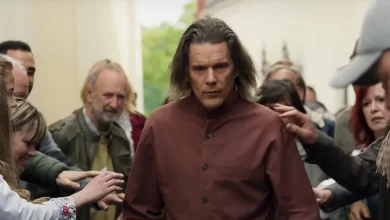The Patient Ending Explained: Is Alan Dead? Who Killed Alan? Does Ezra Forgive Alan?
The Patient Recently available on the Disney+ platform, the ten-episode miniseries (and playing time reduced to just under thirty minutes) The Patient is a psychological thriller that has been favorably received by both audiences and critics. At the center of the story, Dr. Alan Strauss (a Steve Carell at his dramatic consecration), is kidnapped by a former patient and forced by the latter to carry on therapy sessions chained to a bed in a basement. The reason for the kidnapping is soon explained: Sam Fortner (this is the name of the young kidnapper) is a serial killer unable to dominate his compulsion to kill, and who identifies in Dr. Strauss as the last chance to get rid of the shadow that inhabits him.

The Patient, the series is written and created by the two creators of the acclaimed – and award-winning – spy shows The Americans, Joe Wiseberg and Joel Fields, who once again demonstrate their talent for exploiting elements of the thriller genre as springboards to probe psychological aspects. Being a self-contained miniseries, we have all the essential elements to face and try to analyze the perspective of the two authors together, in our explanation of the ending of The Patient.
The Patient Ending Explained: Is Alan Dead? Who Killed Alan? An Impossible Relationship
Two human paths unfold along the course of the ten episodes of The Patient. One belongs to a serial killer and former patient Sam Forten (played by a raincoat Domhnall Gleeson), the other to successful Jewish therapist Alan Strauss (a Steve Carell who gives us a very painful and calibrated interpretation). And if the balance between therapist and patient is already in itself a delicate process that requires mandatory requirements such as trust and willingness to collaborate (which together contribute to the creation of the so-called “safe space”), following the kidnapping of Strauss by in Fortner the dynamic is subverted and distorted, multiplying the levels of complexity of roles: the therapist is at the same time a victim of his patient and adverse circumstances, the patient becomes an executioner who, however, continues to be the helpless victim of himself. It is therefore evident how this new reconfiguration of the parts rests on a distortion that physiologically alters the evolution of the entire process, and which carries within it, right from its premises, the seed of failure.
But, as the episodes proceed, the two human journeys do not develop with equal intensity. Sam Fortner is an all in all ordinary and forgettable serial killer, devoid of those magnetic traits indispensable to make him a subject/object of attention and repulsion. It is true that, given the narrative premises, the forced game has the therapist and his patient as the only two participants (and the metaphorical game then becomes concrete in the ping-pong challenge between the two protagonists), but it is equally certain that the real game accompanying the show is about Dr. Alan Strauss.
Alan Strauss And The Drama Of A Double Game
We were saying that the real game the series focuses on is Dr. Alan Strauss. However, it would be more correct to say that it is a double game, the one concerning his physical survival, which places him in antagonism with his kidnapper and patient, and the one, equally exhausting and exhausting, against the shadows of his past and his many unsolved. Let’s start with the first. About Sam, Strauss is forced to draw on his professional (and rational) resources to lend himself to Sam’s blackmail (without needing to say it explicitly, it is quite clear how the doctor’s survival is closely linked to the success of the therapy). But alongside the “horizontal” dynamic that is established between the two protagonists, the vertical one develops, a tortuous freewheeling descent into the precipices of consciousness, among the traumas and stitches of Strauss’ wounds. It is the emotion that presses from under the blanket of rationality and makes room for itself in the present.
What Do We Know About Dr. Alan Strauss
The long hours spent in anguished solitude, the immobility and the waiting full of frustration are the detonating elements that start the descent path in Strauss’ mind. What is opened up to us, with a dense and satisfying psychological examination, is the experience and inner world of a man who is still metabolizing the loss of his wife and managing his anger towards his son. Through the numerous flashbacks, we discover that the doctor’s son has gradually distanced himself from the family (up to refusing to accompany his mother at the moment of death) after converting to Orthodox Judaism (which, to be clear, adheres to the laws of the Torah in a literal). The anger triggered by the child’s behavior is amplified by frustration and a sense of failure as a father and as a therapist expert in managing parental relationships. In this, acting as a mirror, the figure of Charlie intervenes, the dead ex-analyst and friend of Strauss, who appears to him in semi-hallucinatory moments (“If I’m talking to you, it means that my mind has definitively dissociated”, Alan Strauss will say when he finds himself in the office of his old friend and therapist).
The stratification of Strauss’s mind, a labyrinth made up of previous experiences, vivid dreams (which also draw on the collective unconscious of the Auschwitz concentration camps) and dialogues with imaginary people, therefore enters in clear and effective contrast with the restricted linearity of the space in which he is forced by his captor. The comparison between the past and the current situation becomes unavoidable and leads straight to inevitable questions and excruciating realizations: “I showed more empathy and effort in trying to connect and understand the reasons for a serial killer than I did with my son ”. Because if it is true that the forced conditions and the survival instinct played a decisive role, it is also true that a part of Strauss genuinely sought to contact and water that asphyxiated seed of humanity that can be glimpsed in Sam Fortner. And we, as spectators, witness the disheartening failure of every therapeutic strategy adopted by Strauss, unable to manipulate in his favor an exasperated murderer crushed by his compulsions.
This is Sam Fortner. And despite the glimmers that occasionally illuminate Strauss’ hopes (and with him ours), the reality that takes shape as the finale approaches seems to point straight toward the only possible resolution. unable to manipulate in his favor a murderer exasperated and crushed by his compulsions. This is Sam Fortner. And despite the glimmers that occasionally illuminate Strauss’ hopes (and with him ours), the reality that takes shape as the finale approaches seems to point straight toward the only possible resolution. unable to manipulate in his favor a murderer exasperated and crushed by his compulsions. This is Sam Fortner. And despite the glimmers that occasionally illuminate Strauss’ hopes (and with him ours), the reality that takes shape as the finale approaches seems to point straight toward the only possible resolution.
A Frustrating But Consistent Ending
An ending in which the death by strangulation of Dr. Alan Strauss by Sam is shown without filters. He didn’t make it to the end and kills (with a blade made from foot cream) Sam’s mother, Candace (yet another shattered figure who embodies the role of victim oppressed by her husband and mother who does not know/was able to protect the child). We are not surprised, because Strauss’s vital anger (which is mostly expressed through fantasies in which he imagines smashing a jug on Sam’s head) finds its limit in the general resignation that accompanies his character. Too tired, too old, too sore to be able to prevail with the violence of a vital impulse. He had deluded himself that he could give himself this possibility every second spent sharpening the edge of the tube of cream against the frame of the bed. But in reality, Carell’s gaze (which, we repeat, gives us all his dramatic talent) suggests something else. And it is for this “other” that, in the course of his last hours, he begins to write a letter addressed to his two sons Ezra and Shoshana.
It was the words of former therapist Charlie, who is none other than the ideal personification of his unconscious, that pushed him in this direction: “So, what do you want to do with the day you have left?”. begins to write a letter addressed to his two sons Ezra and Shoshana. It was the words of former therapist Charlie, who is none other than the ideal personification of his unconscious, that pushed him in this direction: “So, what do you want to do with the day you have left?”. begins to write a letter addressed to his two sons Ezra and Shoshana. It was the words of former therapist Charlie, who is none other than the ideal personification of his unconscious, that pushed him in this direction: “So, what do you want to do with the day you have left?”.
In which direction do you choose to channel your psychophysical resources, when the time available shrinks to the point of showing its limit? The choice Strauss opts for is a choice that has to do with the attribution of meaning: that search for meaning that he had tried to activate in Sam, pushing him towards the recognition and reconstruction of his affections (in this case with the ex-wife Mary). It didn’t work for Sam (or it did within the limits that are allowed to him), but it was crucial for Strauss, who begins to cultivate an intimate path of estrangement from life in which the recognition of one’s mistakes, of one’s inability to accept without judging, and the declarations of affection and esteem find form in a letter to the children which contains the meaning of life.






